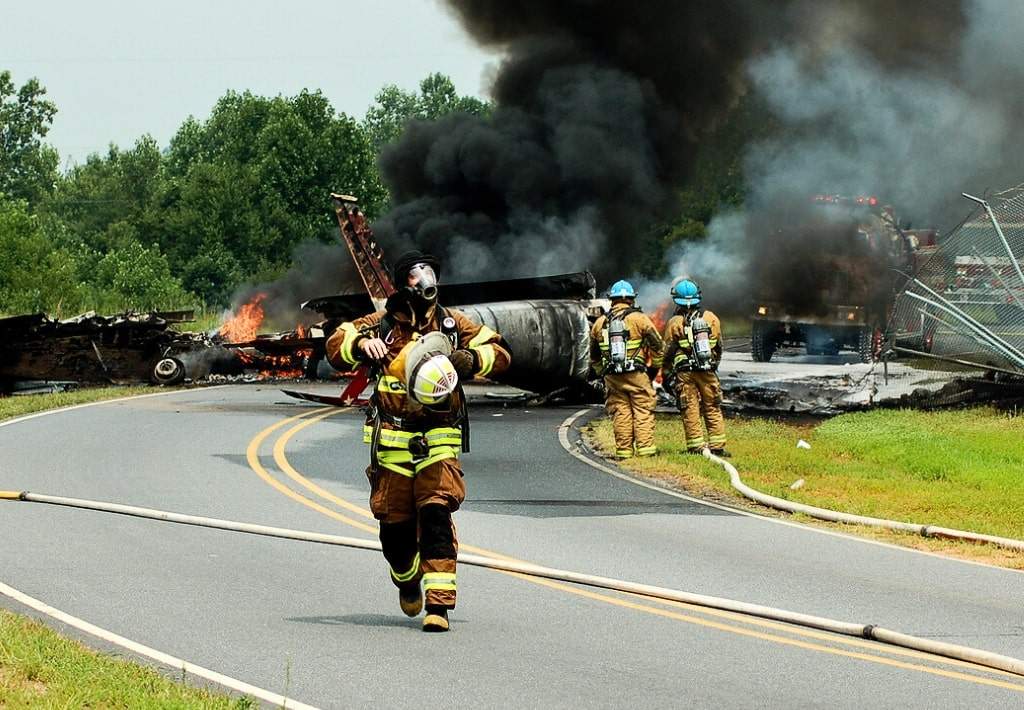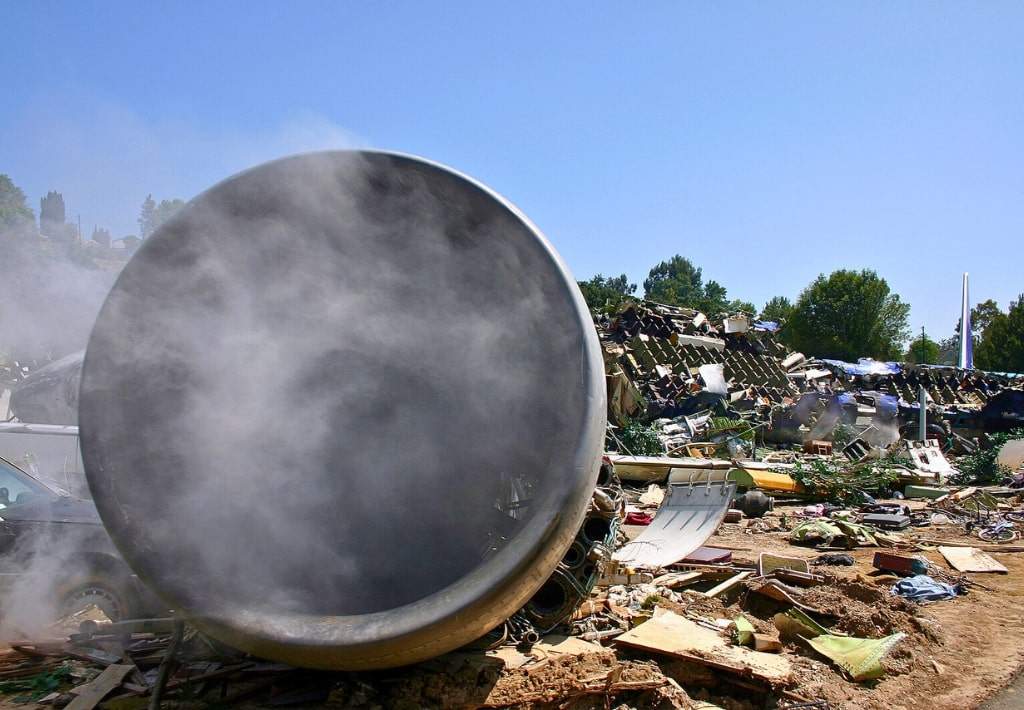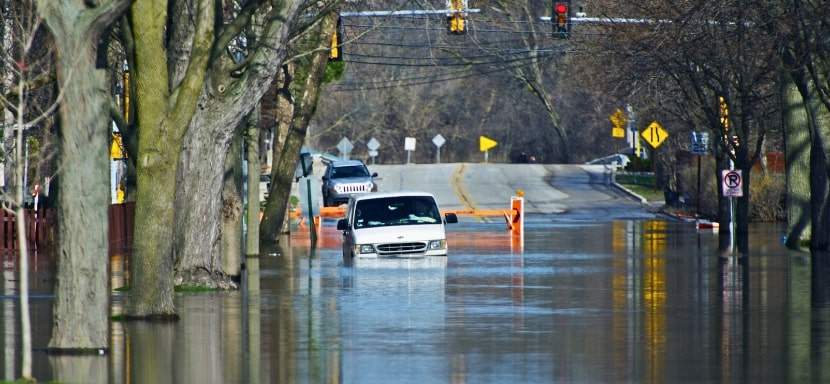How to Survive a Plane Crash

Plane Crash Survival Guide
Statistics state that flying in an aircraft is the safest form of mass transportation. But when planes crash, the casualty count is usually very high. Learn a few tips that may increase your chances of surviving a plane crash.
It may seem unbelievable, but a passenger plane crash can be survivable. Most people involved in a plane crash end up surviving the initial crash and die after the plane has come to rest. This is because many are not prepared for the crash.
Read below for tips on walking away from a plane crash and avoiding becoming a statistic.
Understanding the Odds: Statistics on Plane Crashes
While the thought of being in a plane crash can be unsettling, it’s crucial to understand that air travel remains one of the safest modes of transportation.
You can minimize any perceived risks associated with flying by adhering to safety protocols, staying informed about emergency procedures, and choosing reputable airlines with solid safety records. The numbers regarding the likelihood of being involved in a plane crash might surprise you.
Here are some statistics to put things into perspective:
1. Global Aviation Safety Trends
Over the past few decades, the aviation industry has made remarkable strides in enhancing safety measures. According to the Aviation Safety Network, aviation accidents have steadily decreased despite the significant increase in air travel worldwide.
2. Odds of Being in a Plane Crash
Statistically, the chances of being involved in a plane crash are meager. According to data from the National Transportation Safety Board (NTSB) in the United States, your odds of being in a fatal plane crash are about 1 in 11 million. This means that you’re more likely to win the lottery or get struck by lightning than to be in a plane crash.
3. Factors Influencing Safety
Various factors contribute to the safety of air travel, including:
- Advancements in Technology: Modern aircraft have advanced navigation systems, improved engine efficiency, and enhanced safety features.
- Stringent Regulations: Aviation authorities worldwide enforce strict regulations to ensure that airlines adhere to safety standards and protocols.
- Pilot Training and Expertise: Pilots undergo rigorous training and recurrent evaluations to maintain their skills and proficiency in handling various situations, including emergencies.
- Maintenance Protocols: Airlines follow comprehensive maintenance schedules and conduct regular inspections to ensure the airworthiness of their aircraft.
4. Types of Plane Crashes
Plane crashes can occur due to various factors, including mechanical failures, adverse weather conditions, pilot error, or acts of terrorism. However, it’s essential to note that most air travel incidents are non-fatal, and most accidents result from minor incidents such as runway excursions or bird strikes.
While the thought of being in a plane crash can be unsettling, it’s crucial to understand that air travel remains one of the safest modes of transportation. You can minimize any perceived risks associated with flying by adhering to safety protocols, staying informed about emergency procedures, and choosing reputable airlines with solid safety records.
Plane Crash Dynamics: What Happens During Impact?
Understanding plane crash dynamics is crucial for passengers comprehending what occurs during impact. When a plane crashes, several factors come into play, including the speed and angle of impact, the terrain or surface it crashes into, and the structural integrity of the aircraft.
During impact, the immense kinetic energy of the aircraft transforms into destructive forces, causing deformation and fragmentation of the fuselage, wings, and other components. Passengers may experience sudden deceleration forces, violent shaking, and rapid changes in velocity, leading to injuries ranging from minor bruises to severe trauma.
Fire and smoke may also pose immediate threats, further complicating survival efforts. By understanding these dynamics, passengers can better prepare mentally and physically for the challenges they may face during a plane crash and increase their chances of survival.
Plane Crash Survival Tips and Strategies
Learn vital techniques such as shelter building, water sourcing, fire starting, and signaling for rescue to enhance your chances of survival in remote and challenging environments.
Bigger the Better
Private safety studies show that commercial airlines are four times less likely to be involved in a crash than smaller private jets.
Larger commercial airlines also have better safety records than smaller regional airline companies.

Pick a Safe Seat
Many people like the first few rows on a plane for easy boarding and exit. In reality, the first few rows have the worst survival statistics since the front of an aircraft is more likely to be involved with frontal impacts.
Studies from companies such as Popular Mechanics show that you have a 40 percent better chance of surviving a plane crash the closer you sit to the back of the aircraft. However, further research has proven that this may not be your best choice.
The Five-Row Rule
According to aviation experts, determining the safest seat on a plane is challenging due to the unique circumstances of each crash. While many crashes involve a nose-first impact, others occur tail-first or wing-first, making predictions difficult.
Instead of fixating on seat location, prioritize sitting near an exit. Researcher Ed Galea, the founding director of the Fire Safety Engineering Group (FSEG) of the University of Greenwich in London, found that survivors typically only need to move an average of five rows to escape, with survival rates decreasing beyond this distance.
Aim for an exit row seat, which offers the quickest route to safety. If unavailable, opt for an aisle seat, which provides easier access to facilities and a 64% survival chance compared to 58% for window seats. Avoid bulkhead rows; although they offer extra legroom, the walls provide less cushioning during impact.
90 Seconds!
Understanding the critical 90-second window is paramount for survival and shapes all other advice in this article. After surviving a crash landing, your chances of exiting the airplane alive are favorable, but the clock is ticking – you’ve only got 90 seconds.
The primary threat in a plane crash isn’t the impact but the ensuing fire that often engulfs the aircraft. Survivors may underestimate the speed at which flames spread, leading to complacency.
Contrary to common belief, there’s no luxury of 30 minutes to evacuate; on average, a fire takes just 90 seconds to breach the aluminum fuselage, engulfing everything inside. This reality underscores the urgency to exit the plane swiftly to ensure your safety.
Timing Matters
Studies show that most aircraft emergencies and plane crashes happen three minutes after takeoff and eight minutes before landing. The short term for this is “Plus 3/Minus 8.” As a passenger, this is the most critical time to prepare.
Be alert, keep your area clear, and whatever you do, don’t drink alcoholic beverages, sleep, or take any sleeping aids.
If, by chance, you find yourself in a survival situation, you’ll want to be at your best. Another crash statistic is that most fatalities are not because of the crash but of the ensuing fire.
Safety studies show you have approximately 90 seconds to react quickly and evacuate the plane before the frames consume the cabin.
Brace for Impact
No matter how many times you fly in a plane. You should take two seconds to look at the safety card in the seat pocket. Bracing is probably the most important thing you can do to increase your chances of survival. It can keep you healthy and in one piece to escape the plane after the crash.
The brace for impact position is having your feet resting on the floor with your feet and knees together. Your seat belt should sit low across your thighs, not on your stomach. And your head will be resting on the seat back in front of you.
During impact, this position will prevent your head from slamming into the seat in front of you and your arms and legs from flying around, decreasing the chance of you suffering broken bones.
Did You Know?
You have approximately 20 seconds to put your oxygen mask on before you lose consciousness if your plane loses cabin pressure during an emergency. This is why you’re told to put your mask on first before you assist your child.
Preparation and Safety Measures Before Boarding a Flight
Taking proactive steps to ensure safety before boarding a flight can significantly enhance one’s chances of surviving a plane crash.
Here are some expert tips and strategies to consider:
- Research the Airline: Research the airline’s safety record and reputation before booking your flight. Look for airlines with a strong safety track record and positive customer reviews.
- Choose a Seat Wisely: Opt for a seat near an exit row or overwing an emergency exit, as these seats offer more accessible access to emergency exits in the event of a crash. Avoid seats near the aircraft’s tail, as these are often subjected to greater impact forces during a collision.
- Familiarize Yourself with Safety Procedures: Pay attention to the pre-flight safety briefing and familiarize yourself with the location of emergency exits, oxygen masks, and life vests. Review the safety card in the seat pocket before you to understand proper evacuation and emergency procedures.
- Wear Appropriate Clothing: Wear comfortable clothing and avoid wearing restrictive or bulky attire that may hinder movement during an emergency evacuation. Wear closed-toe shoes to protect your feet from debris and potential hazards.
- Pack Essentials in Carry-On: For added safety, pack essential items such as medications, identification, and important documents in your carry-on luggage. Include a flashlight, whistle, and personal protective equipment such as a face mask and gloves.
In-Flight Emergency Procedures: Knowing Your Options
When faced with an in-flight emergency, clearly understanding your options and knowing how to respond can make all the difference.
Here are some expert tips and strategies to help you navigate in-flight emergencies:
- Stay Calm and Alert: Remaining calm and focused is essential in an emergency. Please heed the flight crew’s instructions and follow their guidance without hesitation.
- Assess the Situation: Take a moment to assess the severity of the emergency and your surroundings. Determine whether the situation requires immediate action or can be managed calmly and safely.
- Follow Crew Instructions: Listen carefully to the flight crew’s announcements and instructions. Follow their directives promptly and cooperate with their requests to ensure the safety of yourself and your fellow passengers.
- Prepare for Evacuation: Familiarize yourself with the location of emergency exits and evacuation procedures. If necessary, be prepared to quickly and safely evacuate the aircraft, following the guidance of the flight crew and using the nearest exit.
- Use Safety Equipment: In the event of an emergency landing or water landing, utilize safety equipment such as life vests and oxygen masks as instructed by the flight crew. Ensure you know how to do and use these devices to maximize your safety correctly.
Emergency Evacuation Techniques: Exiting the Aircraft Safely
Knowing how to exit safely can make all the difference in an emergency evacuation from an aircraft.
Make use of these tips and strategies to help you navigate this critical situation:
- Stay Calm and Follow Instructions: The first rule of any emergency evacuation is to remain calm and follow the instructions of the flight attendants or crew members. Listen carefully to their directions and act quickly but calmly.
- Locate the Nearest Exit: As soon as you board the aircraft, take note of the nearest exit to your seat. This may be behind you, so be sure to look ahead and behind to familiarize yourself with all available exit routes.
- Count the Rows: In low-visibility situations like smoke-filled cabins, counting the rows between your seat and the nearest exit can help guide you to safety. To be prepared, practice counting rows during the pre-flight safety briefing.
- Use the Emergency Slide or Raft: If the aircraft has deployed emergency slides or rafts, follow the instructions for proper use. Remove any high-heeled shoes before sliding down to prevent puncturing the slide.
- Leave Personal Belongings Behind: In an emergency evacuation, leave your belongings behind and focus on exiting the aircraft as quickly as possible. Do not stop to retrieve luggage or personal items, as this can impede your progress and endanger others.
- Stay Low and Move Quickly: If smoke or fire is present, stay low to the ground where the air is more transparent and move quickly but cautiously towards the nearest exit. Cover your nose and mouth with a cloth or clothing to reduce inhalation of smoke or fumes.
- Assist Others if Possible: If you can do so safely, assist children, elderly passengers, or anyone needing help during the evacuation. Offer reassurance and guidance as needed, but prioritize your safety first.
Plane Crash Survival Psychology: Maintaining Calm Amidst Chaos
Maintaining a calm and focused mindset is crucial for making sound decisions and increasing your chances of survival in a plane crash. Here are some expert tips and strategies to help you stay composed amidst chaos:
- Control Your Breathing: When faced with stressful situations, practice deep breathing techniques to help calm your nerves and regain control. Take slow, deep breaths through your nose and out through your mouth to steady your heart rate and clear your mind.
- Focus on the Present: Avoid dwelling on past events or worrying about the future. Instead, focus on the present moment and the tasks at hand. Prioritize your actions based on immediate needs and take one step at a time to address challenges as they arise.
- Stay Positive: Maintain a positive outlook and mindset, even in adversity. Remind yourself of your strengths and capabilities, and believe in your ability to overcome obstacles and survive. Visualize success and focus on solutions rather than dwelling on problems.
- Adaptability is Key: Be flexible and adaptable in your approach to survival. Things may not always go according to plan, but quickly adjusting and improvising can help you overcome unexpected obstacles and find alternative solutions.
- Seek Social Support: Connect with others for emotional support and companionship during difficult times. Lean on friends, family, or fellow survivors for encouragement, reassurance, and camaraderie. Sharing experiences and working together can strengthen resilience and boost morale.
- Stay Grounded in Reality: While it’s important to remain optimistic, staying grounded in reality and assessing situations objectively is also essential. Avoid letting fear or panic cloud your judgment, and make decisions based on facts, logic, and available resources.
- Find Purpose and Meaning: In challenging situations, find purpose and meaning in your actions and circumstances. Focus on what matters most to you and use your strengths and skills to contribute positively to your survival and the well-being of others.
Cold Water
You are less likely to survive if your plane crashes into an ocean, lake, or large body of water because of the risks of hypothermia and drowning.
Can You Survive a Freefall?
Can a human survive a free fall from an airborne plane crash?
Most articles about plane crashes online are assumed to be on a runway or in the water. However, you have a slight chance of survival if your plane is involved in a mid-air collision at 30,000 feet.
The Popular Mechanics magazine says hitting the ground will take about 3 minutes. However, you will probably pass out in the first minute or so. Waking up in just enough time to realize that you’re in trouble and the ground is quickly approaching
You’ll have to think quickly. If possible, don’t aim for water. It’s hard, like concrete, when traveling that fast and from that far up. The perfect landing pad would be swampland or even a snowbank. You will also not want to tuck up into a ball or try to land on your feet.
The best position is face down, with your arms and legs stretched like a spider or skydiver. This will increase the wind resistance under you and slow down your descent before hitting the earth.
Plane Crazy Facts
Here are some facts about aircraft—good, bad, and ugly—that you probably didn’t know.
- Airplane cabins can crawl with germs, and tray tables, seat pockets, and armrests can harbor bacteria like E. coli and MRSA.
- Turbulence can be more intense than you realize, with some instances causing severe injuries and even fatalities with passengers not wearing seatbelts.
- Flying is still among the safest ways to travel.
- Your chances of dying in a plane crash are about 11 million to 1.
- Three minutes after takeoff and 8 minutes before landing is when most aircraft accidents happen.
- When a plane crashes, either almost everyone survives, or virtually no one does.
- You have about 90 seconds to evacuate an aircraft before flames engulf the cabin.
- If you’re not sitting within five rows of an emergency exit, your chances of escaping a plane after a crash are significantly reduced.
- Pilots have admitted to falling asleep at the wheel. Even worse, a third of them said they woke up to find their copilot had also been sleeping!
- Since 1948, 88 planes have disappeared without a trace.
- Planes are not cleaned after every flight. Cold and influenza viruses can live on aircraft for days, turning them into germ hotbeds.
- Oxygen masks aren’t filled with pure oxygen but a mixture of chemicals that produce oxygen when released, which can cause dizziness and nausea.
- The “recycled” air in airplanes is not as fresh as you might think. It often blends outside air with recirculated cabin air.
- Aircraft toilets aren’t emptied mid-flight but store waste in tanks that are only emptied once the plane lands.
- Cabin pressure changes during flight can cause discomfort and even pain in your ears, especially for those prone to ear problems.
- Flying increases your exposure to cosmic radiation, potentially raising the risk of cancer for frequent flyers.
- Airplane food isn’t always prepared fresh; some meals are precooked and reheated, affecting taste and quality.
- The water on planes used for drinking and making coffee or tea is often sourced from tanks that are not always cleaned properly.
- Pilots and crew can fall asleep during long-haul flights, relying on autopilot systems to maintain course and altitude.
- Some aircraft engines are known to catch fire mid-flight, though modern safety measures usually prevent disasters.
- Lightning strikes are relatively common occurrences during flights, though airplanes are designed to withstand them.
- The noise levels inside an airplane can reach up to 105 decibels, equivalent to a chainsaw or rock concert sound.
- In-flight Wi-Fi can be insecure, potentially exposing your personal information to hackers or cyberattacks.
- Airplane windows are small because more oversized windows could weaken the fuselage’s structural integrity.
- Airplane seats are getting smaller, with airlines squeezing in more rows to maximize profits, leading to discomfort for passengers.
- The risk of blood clots, or deep vein thrombosis (DVT), increases during long flights, especially for those with existing health conditions.
- Aircraft engines can fail, though modern planes have redundant systems to prevent catastrophic crashes.
- An airplane’s wings can flex dramatically during flight, which may seem alarming but is a normal part of their design.
- Despite safety measures, the fear of flying, known as aviophobia, affects millions of people worldwide, leading to anxiety and stress when traveling by air.

More Air, Land, and Sea Scenarios
How to Survive a Flash Flood While Driving
Surviving a flash flood while driving requires quick thinking, calmness, and a plan. This guide walks…
How to Survive a Hot Air Balloon Crash
Hot air balloon rides can be magical, with breathtaking views and a serene, floating sensation. But as…
How to Survive a Motorcycle Accident
Life on two wheels is exhilarating, but let’s not sugarcoat it—motorcycle wrecks are a real risk. Whether…
How to Survive a Helicopter Crash
If you ever find yourself in a helicopter plummeting toward the ground, the odds can feel stacked…
How to Survive Being Stuck in an Airport
Travelers love airports, right? You walk in with dreams of quick security checks, ample seating, and maybe…
Recent Survival Posts
How to Survive a Layoff
Layoffs feel personal—even when they’re not. One day, you’re responding to Slack messages and forwarding…
How to Survive a Drug Test
I never imagined I’d be so emotionally invested in a paper cup. But there I was, standing under the fluorescent…
How to Survive an Interrogation
If you’ve ever been caught in the crosshairs of an overly enthusiastic mall cop or stared down by someone…
How to Survive a Nightclub Shooting
Nightclubs pulse with life—lights flashing, music pounding, bodies packed tight on the dance floor. It’s a place to…
How to Survive a Bachelor Party
A bachelor party is a delicate mix of celebration, chaos, and questionable decision-making, wrapped…
More Air, Land, & Sea Survival Scenarios

How to Survive a Hot Air Balloon Crash
Hot air balloon rides can be magical, with breathtaking views and a serene, floating sensation. But as with any adventure, things can go awry. A hot air balloon crash is not a common air survival scenario, yet understanding how to respond effectively can make all the...

How to Survive a Motorcycle Accident
Life on two wheels is exhilarating, but let’s not sugarcoat it—motorcycle wrecks are a real risk. Whether you’re a seasoned rider or just learning, knowing how to survive a motorcycle wreck is crucial. By preparing beforehand, reacting wisely during the incident, and...

How to Survive a Helicopter Crash
If you ever find yourself in a helicopter plummeting toward the ground, the odds can feel stacked against you. You picture fiery explosions, wild spinning blades, and—worst of all—your life flashing before your eyes. But here’s the thing: helicopter crashes are...

How to Survive Being Stuck in an Airport
Travelers love airports, right? You walk in with dreams of quick security checks, ample seating, and maybe a lounge with bottomless snacks. But what if your dream turns into a drawn-out nightmare, and you're stuck there for hours? Or worse, overnight. We've all been...

How to Survive Jet Lag
We’ve all been there: you board a plane full of excitement, jet off to a far-flung destination, and when you arrive, you feel like you’ve been hit by a bus. This, my friends, is jet lag. A cruel reminder that while airplanes can soar at 600 mph, our bodies are...
More Survival Scenarios

How to Survive a Layoff
When the Floor Falls Out: The Reality of a Layoff Layoffs feel personal—even when they're not. One day, you're responding to Slack messages and forwarding emails. Next, you're staring at your monitor as it logs you out... for good. Whether it's a restructuring, a...

How to Survive a Drug Test
The Cup, The Room, The Truth I never imagined I’d be so emotionally invested in a paper cup. But there I was, standing under the fluorescent hum of a strip-mall clinic, trying to recall the last time I ate a poppy seed bagel. That’s the thing about drug tests—they...

How to Survive an Interrogation
If you've ever been caught in the crosshairs of an overly enthusiastic mall cop or stared down by someone in a uniform with a clipboard and a glare, you’ve felt it — the chilly fingers of interrogation anxiety. And while most of us imagine interrogation scenes as...

How to Survive a Nightclub Shooting
Nightclubs pulse with life—lights flashing, music pounding, bodies packed tight on the dance floor. It’s a place to escape, feel the rhythm, and lose yourself in the crowd. But that same energy can turn deadly in seconds, transforming a night of fun into one of the...

How to Survive a Bachelor Party
A bachelor party is a delicate mix of celebration, chaos, and questionable decision-making, wrapped in the noble intention of sending the groom off into married life with a night he’ll (hopefully) remember. It’s a ritual as old as time—well, as old as men deciding...

How to Survive Your First Time at the Gym
Walking into a gym for the first time can feel like stepping into an alien world. The machines hum with purpose, the regulars move confidently, and you’re left standing there, clutching your water bottle, wondering whether you’re in the right place—or on the right...

How to Survive a Worldwide Communications Breakdown
Imagine waking up to silence. Your phone doesn’t buzz, your email won’t load, and even your local radio station crackles with static. A worldwide communications breakdown has hit. What next? For many, this doomsday scenario may sound like the opening lines of a...

How to Survive a Flash Flood While Driving
Surviving a flash flood while driving requires quick thinking, calmness, and a solid plan to ensure your safety. Preparation can make all the difference between a close call and a catastrophe in emergencies like this. This guide provides practical advice to protect...

How to Build an Emergency Kit
Emergencies don’t knock politely at the door. They barge in, uninvited, like a distant relative with a penchant for drama, turning your world upside down without warning. Whether it’s a power outage, a natural disaster, or an unexpected evacuation, the key to staying...

How to Protect Yourself From Insects in the Wild
There’s nothing like being out in the wild—birdsong echoing through the trees, the fresh scent of earth, and a deep sense of peace that makes you think, “Ah, this is what life is about.” But then comes the buzzing. Mosquitoes, ticks, and flies swoop in like uninvited...
